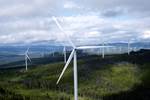MingYang completes 20-MW offshore wind turbine installation
The MySE18.X-20MW, located in China, becomes the largest single-capacity offshore wind turbine on the market.

Source | MingYang Smart Energy
In August, MingYang Smart Energy (Guangdong, China) installed the first of its 20-megawatt (MW) wind turbines in Hainan, China, several sources report. The MySE18.X-20MW, capable of operating between 18-20 MW, becomes what the company claims is currently “the world’s largest single-capacity offshore wind turbine.” Its operation capacity already surpasses the company’s 16-MW platform launched in 2023, in addition to competitors like Dongfang Electric (16-MW), Vestas (15-MW), Siemens Gamesa (14.7-MW) and GE Wind’s Haliade-X (14.7-MW).
The new platform is characterized by its modular, lightweight design using materials like carbon fiber. The rotor has a diameter of 260-292 meters and a maximum swept area of 67 square meters. At an average wind speed of approximately 18 miles per hour, the MySE18.X-20MW can generate 80 million kilowatt-hours annually.
According to JEC Composites, the wind unit is “not only suitable for China’s medium-to-high wind speed and typhoon areas but can also be used in Europe and other international high-wind speed areas.”
The MySE18.X-20MW is just the beginning. Reported by The Maritime Executive, the company reported last October that it is developing “an even larger 22-MW turbine. The company reports it will have a diameter of over 1,000 feet and it expects to demonstrate the unit by 2025.” MingYang adds that, in addition to strong, resilient blades, the turbine will be designed to operate at 19-22-plus mile-per-hour wind speeds.
Related Content
-
Syensqo becomes new Solvay specialty materials company
Syensqo represents what was Solvay Composite Materials, focused on delivering disruptive material technologies and supporting growing customer needs.
-
Paris Air Show 2023 highlights
The Paris Air Show, one of the largest aerospace trade shows in the world, returned for the first time since 2019 and proved that the global aviation industry industry is very much alive and kicking.
-
TU Munich develops cuboidal conformable tanks using carbon fiber composites for increased hydrogen storage
Flat tank enabling standard platform for BEV and FCEV uses thermoplastic and thermoset composites, overwrapped skeleton design in pursuit of 25% more H2 storage.












